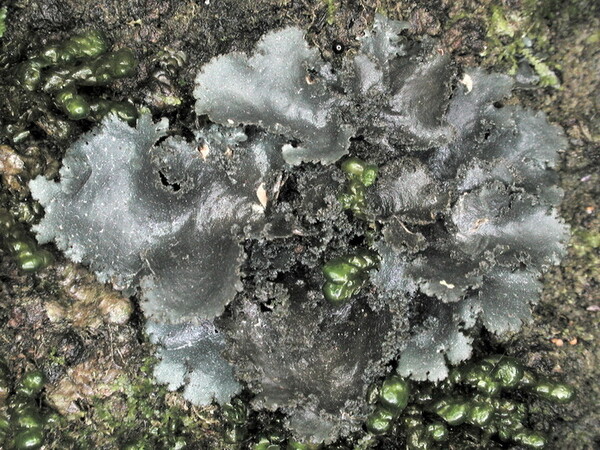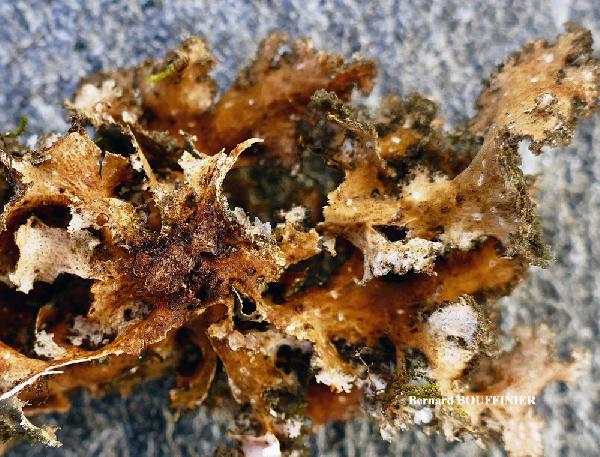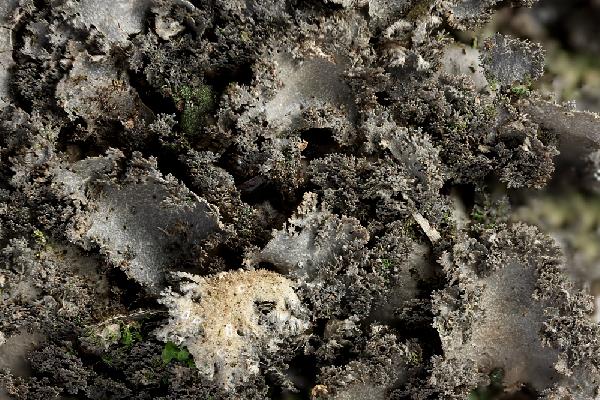Sticta canariensis (Bory) Delise - cyanomorph
Bory ex Delise, Hist. Lich. Sticta: 114, 1822. Basionym: Pulmonaria canariensis Bory in Flörke - Mag. N. Entdeck. Ges. Naturk. Ges. Naturf. Freunde Berlin, 3: 126, 1809.
Synonyms: Sticta canariensis (Bory) Delise; Sticta dufourii Bory ex Delise; Stictina dufourii (Delise) Nyl.
Distribution: C - Tosc. S - Cal (Puntillo 1995, 1996).
Description: Thallus foliose, heteromerous, dorsiventral, broad-lobed, palmate or irregular in outline, loosely attached, blue-grey to grey-brown, sometimes white-marbled, matt, 1-5(-8) cm in diam, often forming large colonies. Lobes suborbicular to ligulate in outline, smooth or rarely scrobiculate-foveolate, rather thin (to 240 μm thick) and brittle when dry, overlapping, rounded, simple or slightly branched, 1-2 cm wide, with ascending, irregularly and minutely incised, phyllidiate margins. Phyllidia 0.5-0.8(-1.2) mm long, dichotomously and several times branched, forming dense, shortly stipitate and imbricate, minute clusters at thallus margins, sometimes invading the surface, concolorous with thallus or darker. Lower surface wrinkled or foveolate, minutely felted-tomentose, pale orange-brown, with whitish, scattered, circular to angular, 0.3-0.8(-1) mm wide cyphellae, whose membrane is made of 1-4 layers of irregular cells. Upper cortex paraplectenchymatous, 20-25 μm thick, with 2–3 layers of isodiametrical cells, or with an upper layer made of a single layer of small cells; medulla white; lower cortex paraplectenchymatous, 20-30 μm thick, with 2-3 layers of isodiametrical cells. Apothecia and pycnidia unknown. Photobiont cyanobacterial (Nostoc, the cells in short chains). Spot tests: thallus and medulla K-, C-, KC-, P-, UV-. Chemistry: without lichen substances.
Note: a humid subtropical lichen found on bark and epiphytic mosses in very moist forests, sometimes on mossy rocks. The morph with cyanobacteria is the only one occurring in Italy. Presently it is probably restricted to a few localities in western Calabria (the records from Tuscany date back to the previous century). It is included in the Italian red list of epiphytic lichens as “Endangered” (Nascimbene & al. 2013c).
Growth form: Foliose, broad lobed
Substrata: bark
Photobiont: cyanobacteria, filamentous (e.g. Nostoc, Scytonema)
Reproductive strategy: mainly asexual, by isidia, or isidia-like structures (e.g. schizidia)
Restricted to humid-warm, oceanic areas
Commonnes-rarity: (info)
Alpine belt: absent
Subalpine belt: absent
Oromediterranean belt: absent
Montane belt: absent
Submediterranean belt: absent
Padanian area: absent
Humid submediterranean belt: absent
Humid mediterranean belt: extremely rare
Dry mediterranean belt: absent
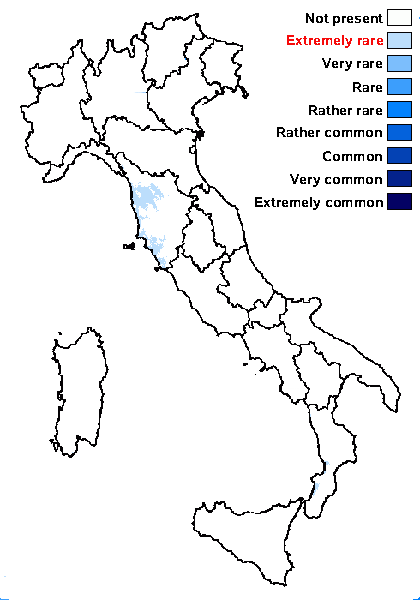
Predictive model
Herbarium samples


P.L. Nimis; Owner: Department of Life Sciences, University of Trieste
Herbarium: TSB (4791)
2001/12/07
isidia
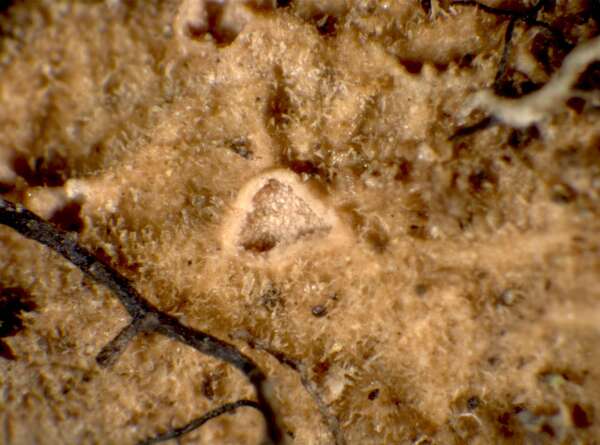

P.L. Nimis; Owner: Department of Life Sciences, University of Trieste
Herbarium: TSB (4791)
2001/12/07
lower surface with tomentum and cyphella


P.L. Nimis; Owner: Department of Life Sciences, University of Trieste
Herbarium: TSB (4791)
2001/12/07
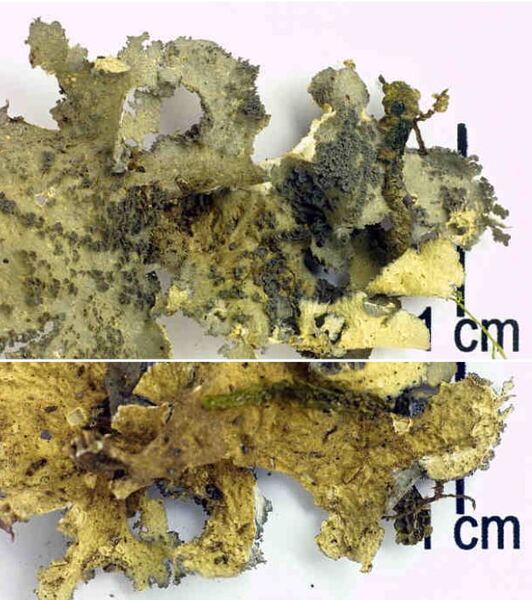

Felix Schumm – CC BY-SA 4.0
Image from: F. Schumm (2008) - Flechten Madeiras, der Kanaren und Azoren. Beck, OHG - ISBN: 978-3-00-023700-3
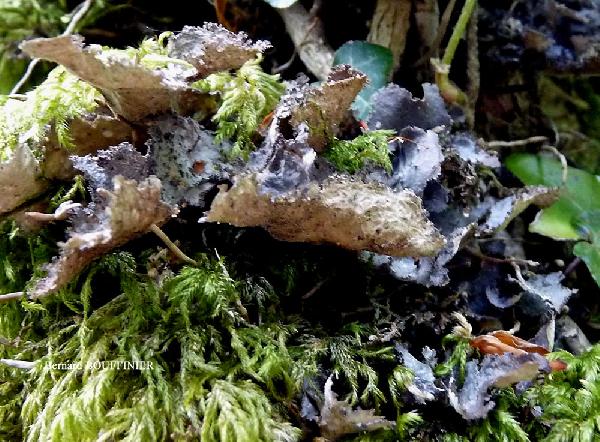
Bernard Bouffinier - Source: http://www.lichensmaritimes.org/index.php?task=fiche&lichen=372&lang=en
France, Forêt du Cranou
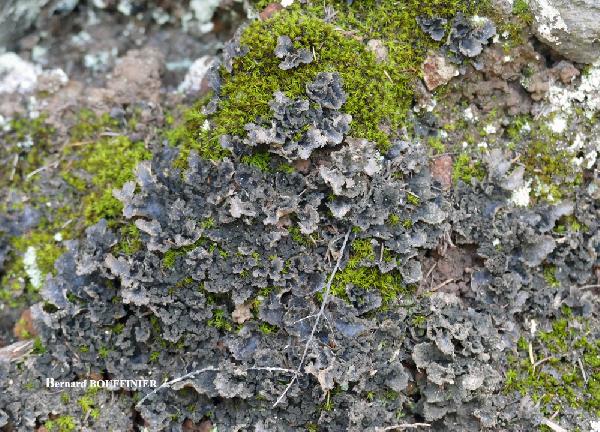
Bernard Bouffinier - Source: http://www.lichensmaritimes.org/index.php?task=fiche&lichen=372&lang=en
Spain, Canary Islands, Tenerife
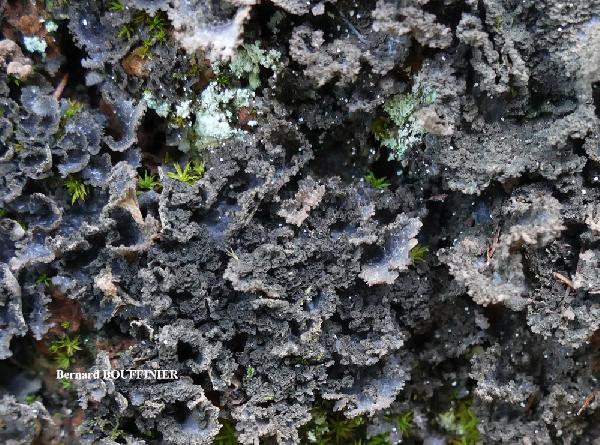
Bernard Bouffinier - Source: http://www.lichensmaritimes.org/index.php?task=fiche&lichen=372&lang=en
Spain, Canary Islands, Tenerife

Bernard Bouffinier - Source: http://www.lichensmaritimes.org/index.php?task=fiche&lichen=372&lang=en
Spain, Canary Islands, Tenerife
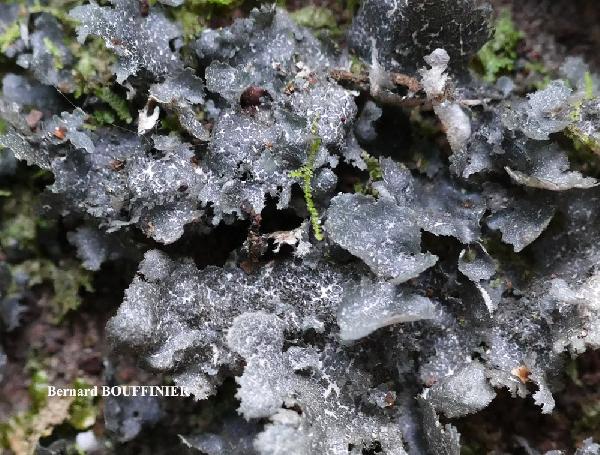
Bernard Bouffinier - Source: http://www.lichensmaritimes.org/index.php?task=fiche&lichen=372&lang=en
Spain, Canary Islands, Tenerife
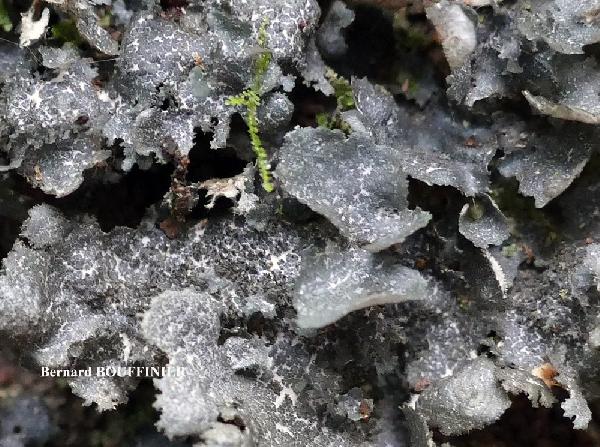
Bernard Bouffinier - Source: http://www.lichensmaritimes.org/index.php?task=fiche&lichen=372&lang=en
Spain, Canary Islands, Tenerife
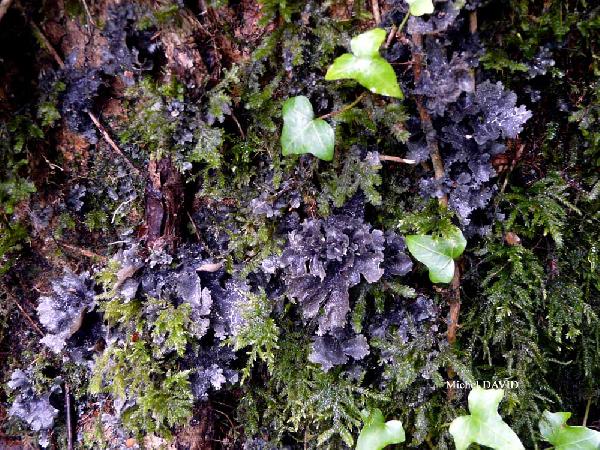
Michel David - Source: http://www.lichensmaritimes.org/index.php?task=fiche&lichen=372&lang=en
France, Forêt du Cranou
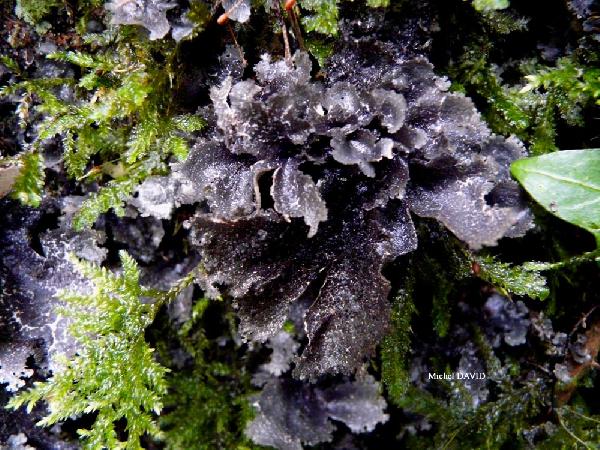
Michel David - Source: http://www.lichensmaritimes.org/index.php?task=fiche&lichen=372&lang=en
France, Forêt du Cranou
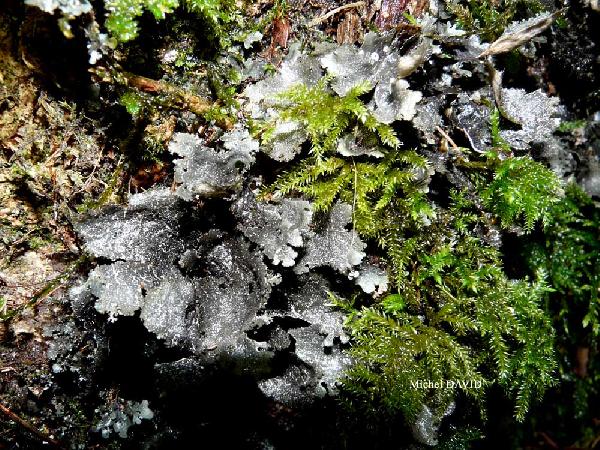
Michel David - Source: http://www.lichensmaritimes.org/index.php?task=fiche&lichen=372&lang=en
France, Forêt du Cranou
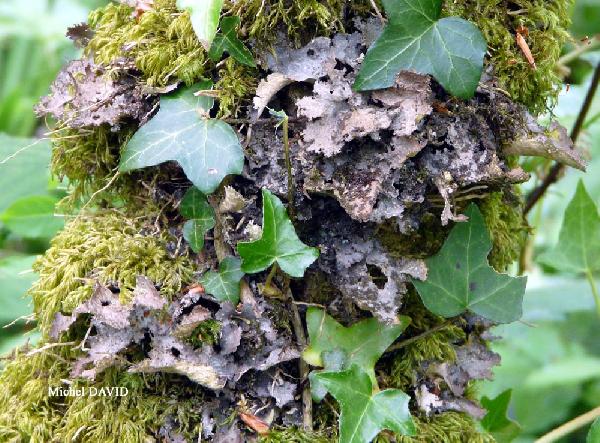
Michel David - Source: http://www.lichensmaritimes.org/index.php?task=fiche&lichen=372&lang=en
France, Forêt du Cranou
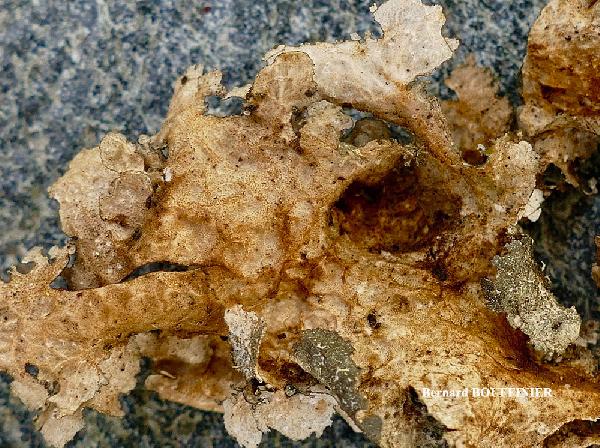
Bernard Bouffinier - Source: http://www.lichensmaritimes.org/index.php?task=fiche&lichen=372&lang=en
Spain, Canary Islands, Tenerife
Growth form: Foliose, broad lobed
Substrata: bark
Photobiont: cyanobacteria, filamentous (e.g. Nostoc, Scytonema)
Reproductive strategy: mainly asexual, by isidia, or isidia-like structures (e.g. schizidia)
Restricted to humid-warm, oceanic areas
Commonnes-rarity: (info)
Alpine belt: absent
Subalpine belt: absent
Oromediterranean belt: absent
Montane belt: absent
Submediterranean belt: absent
Padanian area: absent
Humid submediterranean belt: absent
Humid mediterranean belt: extremely rare
Dry mediterranean belt: absent

Predictive model
| Herbarium samples |


P.L. Nimis; Owner: Department of Life Sciences, University of Trieste
Herbarium: TSB (4791)
2001/12/07
isidia


P.L. Nimis; Owner: Department of Life Sciences, University of Trieste
Herbarium: TSB (4791)
2001/12/07
lower surface with tomentum and cyphella


P.L. Nimis; Owner: Department of Life Sciences, University of Trieste
Herbarium: TSB (4791)
2001/12/07


Felix Schumm – CC BY-SA 4.0
Image from: F. Schumm (2008) - Flechten Madeiras, der Kanaren und Azoren. Beck, OHG - ISBN: 978-3-00-023700-3

Bernard Bouffinier - Source: http://www.lichensmaritimes.org/index.php?task=fiche&lichen=372&lang=en
France, Forêt du Cranou

Bernard Bouffinier - Source: http://www.lichensmaritimes.org/index.php?task=fiche&lichen=372&lang=en
Spain, Canary Islands, Tenerife

Bernard Bouffinier - Source: http://www.lichensmaritimes.org/index.php?task=fiche&lichen=372&lang=en
Spain, Canary Islands, Tenerife

Bernard Bouffinier - Source: http://www.lichensmaritimes.org/index.php?task=fiche&lichen=372&lang=en
Spain, Canary Islands, Tenerife

Bernard Bouffinier - Source: http://www.lichensmaritimes.org/index.php?task=fiche&lichen=372&lang=en
Spain, Canary Islands, Tenerife

Bernard Bouffinier - Source: http://www.lichensmaritimes.org/index.php?task=fiche&lichen=372&lang=en
Spain, Canary Islands, Tenerife

Michel David - Source: http://www.lichensmaritimes.org/index.php?task=fiche&lichen=372&lang=en
France, Forêt du Cranou

Michel David - Source: http://www.lichensmaritimes.org/index.php?task=fiche&lichen=372&lang=en
France, Forêt du Cranou

Michel David - Source: http://www.lichensmaritimes.org/index.php?task=fiche&lichen=372&lang=en
France, Forêt du Cranou

Michel David - Source: http://www.lichensmaritimes.org/index.php?task=fiche&lichen=372&lang=en
France, Forêt du Cranou

 INDEX FUNGORUM
INDEX FUNGORUM
 GBIF
GBIF

